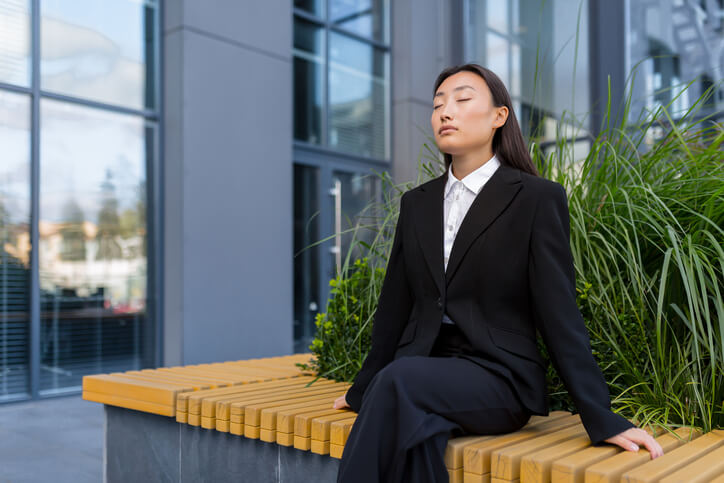 Any review of the research done on meditation makes it hard to ignore the benefits. Meditation improves mood, feelings of well-being, sleep, and decreases pain. Mindfulness meditation asks you to appreciate the moment you are in. It can halt the busy mind and prevent useless fretting about the past or future.
Any review of the research done on meditation makes it hard to ignore the benefits. Meditation improves mood, feelings of well-being, sleep, and decreases pain. Mindfulness meditation asks you to appreciate the moment you are in. It can halt the busy mind and prevent useless fretting about the past or future.
Unfortunately, our modern life often doesn’t offer much free time to pause and develop a meditation practice. Taking time to meditate can mean taking time away from other valuable uses of free time. For example, an hour spent in meditation can mean sacrificing time at the gym or with family for the busy adult. So is there another way? Can meditation be practiced in daily life without dedicating a specific chunk of time?
Despite the many pleasant side effects of meditation, it can be hard to dedicate time to sit quietly. Mindfulness meditation easily lends itself to a practice of "active meditation" or "meditation in motion." As you might guess, this type of meditation allows you to continue with daily tasks while taking time to focus on the present moment.
You can practice active mindfulness meditation in different ways and in other places. Any tasks that are repetitive throughout your day will be the perfect opportunity. Engaging in mindfulness when you are doing a task requires you to focus on the sensations you experience. For example, focus on something you can hear or smell or taste.
There is a method that works well for adults and children. This method asks you to first focus on your breathing. Take a full minute to take deep, calming breaths.
Then focus on:
This process brings you into the present moment. A bustling mind will appreciate the task of counting out what you notice.
This method can be used when taking a shower, waiting to pick up your coffee, or chopping vegetables. Then, if you finish and have more time, you can repeat the process.
Active mindfulness can also be practiced when walking.
Thich Nhat Hanh, a master of zen meditation, recommends a process for walking meditation. First, he encourages us to imagine each step as a peaceful one. Then, to put the "mind at the sole of the foot." If you imagine this, your concentration is focused on your feet and the process of walking.
When walking to and from your car or to the bathroom and back, take time to feel every step. Feel your socks and shoes and how they move with you. Thich Nhat Hanh says you should "kiss the ground with your feet." You can bring in gratitude here and thank the earth for holding you up or thank the city for paving the roads. You could thank your body for helping you get from place to place.
Gratitude mindfulness is another method that can be used to focus the mind when moving through a busy day. Gratitude mindfulness asks you to consider the multitude of things to be grateful for. If you like the "5 things, you see" method; you can modify it to be five things you see that inspire gratitude. You can make lists of things you are grateful for while you are driving or waiting for your lunch order.
Gratitude as a practice has many benefits similar to that of meditation. For example, gratitude has been found to increase happiness levels, decrease blood pressure, and improve friendships.
If you have two minutes to yourself, you can do a form of active Osho meditation. Like a dog shaking off water, shake your body for 20-30 seconds, then go still. Put your hands together in the middle of your chest and spend one-minute generating feelings of gratitude.
Loving-kindness mindfulness is another style of meditation. Practicing loving-kindness involves generating feelings of self-love and well-being. If you are able to feel a strong sense of self-love, then begin to concentrate on the love you feel for family and friends.
If you have 5 minutes at your desk or in your car before work, close your eyes and imagine a white or gold bubble of light. Let the light flow over you and imagine it is pure love. Let it sink into your body, and then imagine it shooting out from you to a loved one.
Finally, a mindfulness body scan can be a quick way to connect your body and the present moment. Body scans involve bringing your attention to one end of the body and noticing feelings of tension or ease. Accept any sensations you experience and let them float by. Then, if you have the time when finished, imagine that same gold light filling up your body from bottom to top.
In certain seasons of life, all our days feel busy. If establishing a mindfulness meditation practice feels out of reach, a few minutes a day can have similar results. A short daily practice can lay a foundation for overall better mental and physical health. So notice things around you, kiss the earth with your feet, shake like a dog or send out love; it will be worth it.